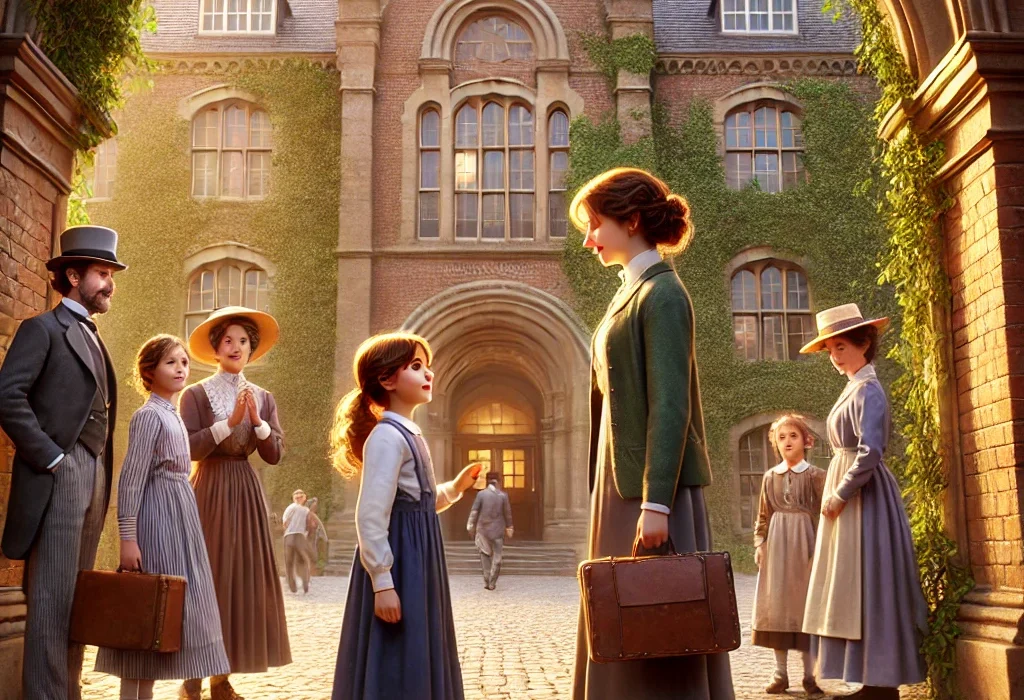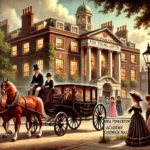What Katy Did at School by Susan Coolidge, published in 1873, is the second book in the Katy Did series. Following the events of What Katy Did, where Katy Carr learned patience and resilience after a serious accident, this novel focuses on her experiences at a boarding school, Hillsover. Set in the post-Civil War era, the story explores the transition from childhood to adolescence, touching on themes like friendship, discipline, and personal growth as Katy and her sister Clover navigate the new environment of a strict boarding school.
Plot Summary
After Katy Carr’s long recovery from her spinal injury, her world had finally opened up again. The once bed-bound girl was now filled with joy and energy, and her father, Dr. Carr, believed it was time for a new adventure that would shape her further. He proposed that Katy and her younger sister Clover should attend boarding school, Hillsover, in the East. Though Katy was apprehensive about leaving home and her family, the excitement of something new stirred within her. Soon, preparations were underway, trunks packed, and goodbyes exchanged.
The school, known among the students as “The Nunnery,” was located in a cold, hill-surrounded town. It was a far cry from the warm, bustling home Katy and Clover had left behind. They traveled for days to reach it, their journey marked by curiosity and a little apprehension. When they finally arrived, the imposing structure of Hillsover and the strict regimen imposed by Mrs. Florence, the headmistress, made the school seem even more daunting.
Upon their arrival, Katy and Clover were assigned to a room in Quaker Row, one of the dormitory sections of the school. Here, they quickly realized that life at Hillsover was ruled by an endless list of rules: punctuality, cleanliness, silence in the halls. Miss Jane, one of the stricter teachers, enforced these rules with an iron hand. However, despite the rigid atmosphere, Katy and Clover soon made friends, notably the mischievous and lively Rose Red, whose real name was Rosamond Redding. Rose Red became their closest friend, her daring spirit a bright contrast to the otherwise subdued life at school.
Katy, now accustomed to responsibility after her years of illness, initially tried to adapt to the school’s routine without complaint. She helped Clover adjust, and both sisters quickly gained the respect of their classmates for their good nature and willingness to help. However, Katy’s impulsive and independent streak was hard to suppress, and soon, she found herself caught up in Rose Red’s pranks and schemes.
Rose Red’s antics brought much-needed laughter to the otherwise monotonous days at Hillsover. She was always cooking up some new mischief—slipping humorous notes to fellow students during silent study hours or devising ways to outwit Miss Jane’s constant surveillance. Katy, though she initially hesitated to break any rules, found herself drawn into the fun. The pranks gave the girls a sense of freedom in a place that felt suffocating with its never-ending list of dos and don’ts.
Still, beneath the fun, there were moments of homesickness. Katy missed her father and younger siblings deeply. Letters from home were treasured, each one bringing a little piece of Burnet into the cold, austere school. Clover, too, felt the pangs of longing for home, but the sisters had each other, and that made all the difference. Their shared moments—quiet talks at night, comforting one another through the tough times—strengthened their bond.
The routine at Hillsover was a mixture of the academic and the personal. Classes filled the days, with lessons in literature, mathematics, and French. While Clover enjoyed the structure and predictability, Katy sometimes chafed under the constraints, longing for more freedom. There were also public prayers, silent meals, and strict orders about how the girls should conduct themselves at all times. It was a place of rules, discipline, and constant observation, which was challenging for a girl as free-spirited as Katy.
As the weeks passed, Katy’s playful side began to show itself more openly. With Rose Red as her co-conspirator, she became more willing to take risks, even if it meant bending the rules. Their mischief reached its peak during one of the most memorable escapades at Hillsover: Rose Red, with Katy’s help, devised a daring plan to sneak into Mrs. Florence’s private parlor, a space strictly off-limits to the students. The girls tiptoed through the halls in the dead of night, hearts racing with a mixture of fear and exhilaration. They successfully slipped into the parlor, but their victory was short-lived. Miss Jane, ever-vigilant, caught them and reported the incident to Mrs. Florence.
Katy and Rose were summoned to face the headmistress. Mrs. Florence, tall and commanding, was not one to overlook such transgressions. The gravity of the situation weighed heavily on Katy as Mrs. Florence delivered a stern reprimand. Rose Red’s mischievous charm might have helped soften the blow, but for Katy, the shame of breaking the rules and disappointing Mrs. Florence struck deep. This incident served as a turning point for her.
From that moment, Katy began to take her responsibilities more seriously. She realized that while fun and adventure had their place, she didn’t want to lose the respect she had earned. Her growth from this experience reflected her increasing maturity. She still joined in with Rose Red and the others, but there was a new balance in her life—one where she could enjoy her friends and their laughter but also take pride in her work and behavior.
By the end of the school year, Katy had not only made lifelong friends but had also learned important lessons about self-control, responsibility, and the importance of finding joy within boundaries. Clover, who had quietly blossomed in her own way, was proud of her sister, as was everyone who had seen Katy’s transformation from an impulsive girl to a thoughtful and balanced young woman.
As the time came for them to return home, Katy and Clover left Hillsover with mixed feelings. They had grown to appreciate the discipline of the school, but more importantly, they cherished the friendships and the growth they had experienced. Boarding the train home, they looked forward to reuniting with their family, but they also carried with them the memories of a year that had tested and strengthened them in ways they had never imagined.
Main Characters
Katy Carr: The central character of the series, Katy is now a young woman who has recovered from the spinal injury that confined her to bed in the first book. She is kind-hearted, responsible, and imaginative, but she still retains some impulsive and headstrong traits. Katy’s experiences at school help her mature and develop deeper self-awareness.
Clover Carr: Katy’s younger sister, Clover is gentle, thoughtful, and caring. She follows Katy to Hillsover, and her supportive nature makes her a beloved companion not only to Katy but also to other students at the school. Clover often acts as a stabilizing influence on her more impulsive older sister.
Rose Red (Rosamond Redding): Rose Red is a lively, mischievous, and fun-loving girl at the school. She quickly becomes Katy’s best friend, known for her pranks and rebellious attitude, but she has a good heart and is extremely loyal to her friends. She brings humor and adventure into Katy’s life at Hillsover.
Miss Jane: One of the school’s teachers and disciplinarians, Miss Jane is strict, rule-bound, and feared by many of the students. She represents the rigid discipline and traditional values of the school, often clashing with the free-spirited students.
Mrs. Florence: The headmistress of Hillsover School, Mrs. Florence is respected by the girls for her intelligence and authority. While stern, she has a deeper understanding of the students than they realize, often guiding them in their personal development.
Theme
Education and Discipline: One of the central themes of the novel is the role of education, not only in academic learning but also in shaping character. The strict rules at Hillsover teach Katy and the other girls discipline, self-control, and responsibility, though they sometimes resist the rigidity of the system.
Friendship and Loyalty: Friendship plays a crucial role in What Katy Did at School. The relationships Katy forms, particularly with Rose Red and Clover, help her navigate the challenges of school life. These friendships provide emotional support and contribute to her personal growth.
Personal Growth and Maturity: Katy’s journey is one of continued personal growth. Having learned patience from her time of illness, she now learns independence, self-reliance, and how to balance fun with responsibility. Boarding school acts as a crucible for Katy to develop into a more mature, thoughtful young woman.
Rebellion vs. Authority: The tension between the students’ desire for freedom and the school’s strict rules is a recurring motif. Rose Red represents the rebellious spirit, often pushing against the rules, while figures like Miss Jane represent the institutional authority that tries to contain the girls’ exuberance.
Writing Style and Tone
Susan Coolidge’s writing in What Katy Did at School is charming and light-hearted, reflecting the youthful spirit of her protagonists. The tone of the book is primarily optimistic and warm, even when dealing with challenges or conflicts. Coolidge captures the innocence and energy of the girls’ adventures while also addressing deeper themes of growing up. Her style is conversational, making the reader feel intimately involved in Katy’s experiences.
The narrative voice is compassionate and understanding of the characters’ emotions, particularly in moments of homesickness or rebellion. Coolidge excels at portraying the ups and downs of adolescent life, balancing humor with more serious reflections on character and virtue. The novel’s tone also shifts at times to reflect the strictness of the boarding school, providing a contrast between the girls’ lively personalities and the rigid expectations placed upon them.
We hope this summary has sparked your interest and would appreciate you following Celsius 233 on social media:
There’s a treasure trove of other fascinating book summaries waiting for you. Check out our collection of stories that inspire, thrill, and provoke thought, just like this one by checking out the Book Shelf or the Library
Remember, while our summaries capture the essence, they can never replace the full experience of reading the book. If this summary intrigued you, consider diving into the complete story – buy the book and immerse yourself in the author’s original work.
If you want to request a book summary, click here.
When Saurabh is not working/watching football/reading books/traveling, you can reach him via Twitter/X, LinkedIn, or Threads
Restart reading!








